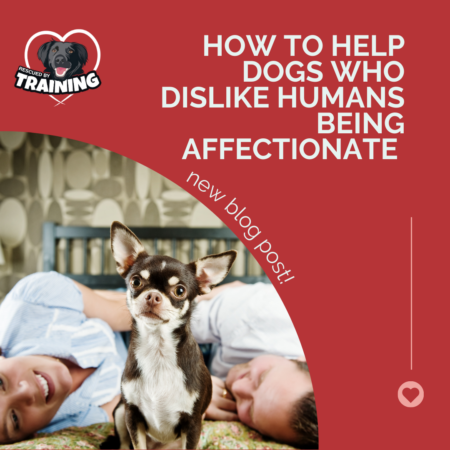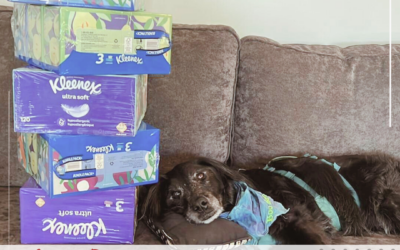Over the years I’ve had clients come to me sheepishly asking for help because their dog doesn’t like when they are getting intimate or showing affection like handshakes, hugging or kissing with other humans. And kudos for them being brave enough to ask for help! Dogs who present like this often jump up on people when they’re hugging, kissing or otherwise showing affection. They may also try to wedge in between, bark, air snap or even bite. I had a client once who really didn’t like when the parents gave their child a piggyback ride and he’d air snap or nip at the child’s behind. Often people chalk this up as the dog being jealous or thinking the other person is trying to hurt their favorite person but is that what’s going on?
Well, I don’t think we can know exactly what is going on quite yet. There is some inconclusive research on the topic of that jealousy isn’t exclusively a human emotion, and Mark Bekoff in his book, Canine Confidential: Why Dogs Do What They Do, talks about the data and neuroimaging studies that show dogs are emotional beings (you can read an interview with him here) but there’s not a wealth of research to be able to conclusively say dogs have jealousy.
But just because we don’t know why our dogs are reacting this way, doesn’t mean we can’t help them, and in turn, help ourselves! Perhaps the dog is upset, or guarding their favorite person. Perhaps they’ve got a touch of FOMO and are frustrated. But, whether the dog is upset or not doesn’t matter here – we can help them.
What does person guarding look like?
Sometimes dogs will guard their favorite person and growl or show signs of discomfort when someone approaches when they’re near their favorite person. When we suspect guarding of the favorite person, especially when this happens with strangers, we need to do a rule out for stranger danger. Often people will self-diagnose their dog as “guarding them” but more often than not, after doing a consult, the dog isn’t guarding at all – the dog has stranger danger, or fear of unfamiliar people. People jump to the conclusion their dog is guarding them, maybe because it makes us feel a little better to think our dog loves us so much they want to protect us, rather than coming to terms with the fact that their dog is afraid of people.
Where do I see person guarding? Usually in the home, guarding against a family member, partner or spouse. The scenario usually looks something like this: Dog and favorite person are sitting on the couch or in bed together and the partner comes to sit on the couch or get into the bed, and the dog growls or lunges at the person. In this scenario we’d need to do some digging to ensure the dog isn’t location guarding and that there’s not a history of the partner forcibly removing the dog in these contexts, as that can make the guarding worse.
So what do we do?
- Management: Sets you and your dog up to succeed. This means, using a physical barrier (baby gate, pen, crate, tether or leash) so the dog doesn’t have access to guard
- Prevention: Ensures your dog isn’t rehearsing unwanted behaviors, possibly making them stronger
- Training: Teaching an alternate, incompatible behavior that we can heavily reward so we can say “yes, do this”, instead of “no, stop doing that”.
- Reminder: Never use punishment, including pushing the dog away, as this could create a negative association and make things worse
If this topic interests you, you may also like my Resource Guarding Series. Click that link if you’ve missed any of the previous posts.
If you have a guarder, whether it’s food, toys, location, favorite person or high value chews, or any other fear or aggression issues, please reach out to me for help. And be sure to sign up for my free weekly newsletter so you don’t miss out on free tips, videos, personal stories, client successes and more!
Happy training!
![]()




